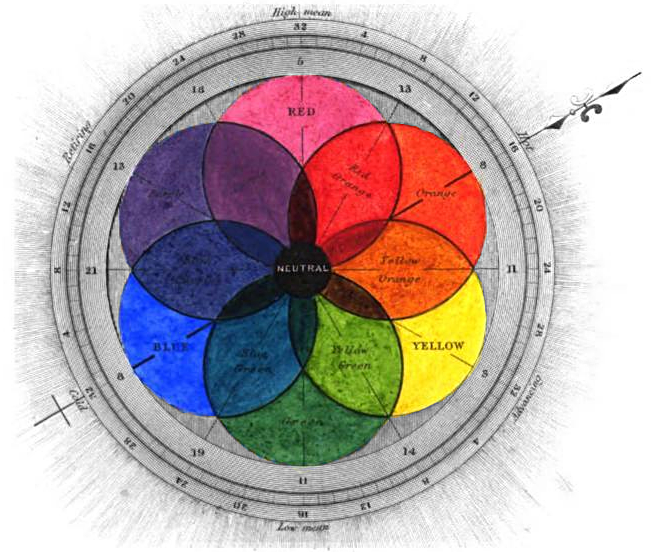
This is part two of a three-part series on color. Part one was Color Therapy & Healing. You can read part three: The Psychological Effects of Color, where we will delve into the psychology of some specific colors and how they might affect your everyday life.
Here are the topics covered in this article:
- The Meaning of Colors You Choose
- How Do We See Color?
- The Traditional Color Wheel
- What is Color Symbolism?
- Examples of Cultural & Religious Symbolism of Color
- Color Meanings & Symbolism of Primary and Secondary Colors
- Color Meanings/Symbolism Charts
- Books About Color Symbolism & Meaning
The Meaning of Colors You Choose
Carl Jung, a renowned psychiatrist and proponent of art therapy, encouraged his patients to use color because he felt this would help them express some of the deeper parts of their psyche. It is believed that the color choices you make reflect a deeper meaning about your personality traits. For example, introverts and extroverts are likely to choose different colors – blue and red respectively.
The colors you choose to wear might also say something about how you are feeling that day. Some days you may fee like wearing something lighter, something red, or something blue. These choices are often a reflection of how you are feeling at the moment. Additionally, wearing certain colors may cause you to react differently to certain situations.
How Do We See Color?
There are 2 main sources of light that create the colors we see: the sun and lightbulbs. As you know, the light from the sun allows us to see things during the day as well as during the night when the sun’s light reflects off the moon. There is a visible spectrum of colors that we can see in addition to the combination of all colors (white) and the absence of color (black).
Surfaces reflect and absorb light differently, which results in the colors we see through our eyes. For example, a tomato absorbs all light on the spectrum except the red rays of light. The red rays of light are reflected off the surface of the tomato which then reach our eyes for processing.
The colored light enters the eye through the pupil, goes through the lens, then reaches the back of the eye called the retina. On the retina there are a bunch of light sensors called rods and cones. These rods and cones send a signal to the brain about what the eye is seeing. The cones are capable of seeing three colors: red, green, and blue. These are known as primary colors (RGB Model) – more about this below.
The Traditional Color Wheel – primary, secondary, and tertiary colors
Here you can see a basic color wheel. It is based on 3 different types of colors: primary, secondary, and tertiary.
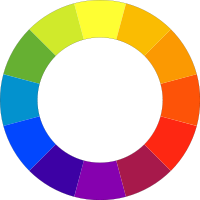
Primary Colors (Traditional RYB Model)
Primary colors consist of red, yellow, and blue. These 3 hues can not be mixed or formed by any combination of other colors. Additionally, all other colors are created by mixing these three colors.
Secondary Colors
Secondsary colors consist of green, orange and purple (violet). Secondary colors are formed by mixing 2 primary colors.
Tertiary Colors
Tertairy colors consiste of red-orange, yellow-orange, yellow-green, blue-green, blue-violet, and red-violet. Tertiary colors are formed by mixing primary and secondary colors, resulting in the two-word names.
If you’d like to know more about RGB and RYB models, CMYK, reflective and transmitted light, then there are lots of additional sources out there that cover more in-depth color theory. These are just some basic concepts for our series on color therapy, meanings, symbolism, et cetera.
Now that we’ve covered the basics of traditional color theory, let’s review color symbolism.
What is Color Symbolism?
Color symbolism is the use of color as a representation or meaning of something that is usually specific to a particular culture or society. Context, culture and time are certainly important factors to consider when thinking about color symbolism.
Examples of Cultural & Religious Symbolism of Color
Depending on the culture or society, colors may symbolize diffferent things for different people. Consider the United States as an example. What colors come to mind when you think about traffic lights and signs? What about the flag? How about Christmas or Halloween?
Even within the United States, there are cultures that hold certain colors sacred. For example, at least 3 Native American nations hold the same three colors sacred: black, white and yellow. Although, they each have 4 different colors they hold sacred in addition to black, white and yellow.
Navajo Nation –> turquoise
Apache Nation –> green
Iowa Nation –> red
Color Meanings of Primary and Secondary Colors
The following is a list of primary and secondary colors and possible meanings of each color. Feel free to add your own suggestions in the comments. You can also view these charts as well as the main Color Symbolism Chart:
Next, you’ll find some common color meanings and symbolism of the 6 main colors…
Meaing of the Color Red:
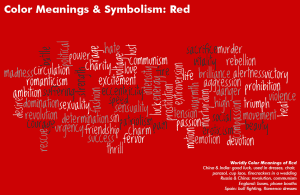
From: Color Symbolism Chart – RED
Cultural Color Symbolism & Meanings of Red
China & India: good luck, used in dresses, chair, parasol, cup lace, firecrackers in a wedding
Russia & China: revolution, communism
Mayas: south
England: buses, phone booths
Spain: bull fighting, flamenco dresses
Typical Meanings & Symbolisms of the Color Red:
|
|
Meaning of the Color Orange
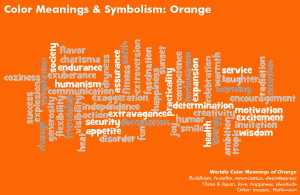
From: Color Symbolism Chart – ORANGE
Cultural Color Symbolism & Meanings of Orange
Buddhism: humility, renunciation, desirelessness
China & Japan: love, happiness, plenitude
Other: treason, Halloween
Typical Meanings & Symbolisms of the Color Orange:
|
|
Meaning of the Color Yellow
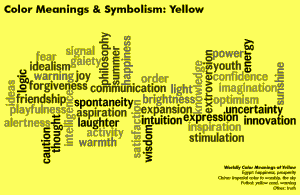
From: Color Symbolism Chart – YELLOW
Cultural Color Symbolism & Meanings of Yellow
Egypt: happiness, prosperity
China: Imperial color to worship, the sky
Futbol: yellow card, warning
Other: truth
Typical Meanings & Symbolisms of the Color Yellow:
|
|
Meaning of the Color Green
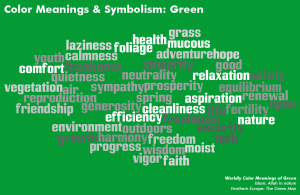
From: Color Symbolism Chart – GREEN
Cultural Color Symbolism & Meanings of Green
Islam: Allah in nature
Northern Europe: The Green Man
Typical Meanings & Symbolism of the Color Green:
|
|
Meaning of the Color Blue
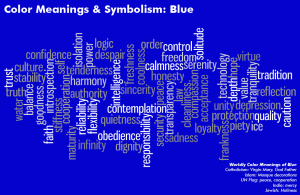
From: Color Symbolism Chart – BLUE
Cultural Color Symbolism & Meanings of Blue
Catholicism: Virgin Mary, God Father
Islam: Mosque decorations
UN Flag: peace, cooperation
India: mercy
Jewish: Holiness
Typical Meanings & Symbolism of the Color Blue:
|
|
Meaning of the Color Purple (Violet)
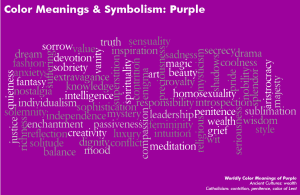
From: Color Symbolism Chart – PURPLE
Cultural Color Symbolism & Meanings of Purple or Violet
Ancient Cultures: wealth
Catholicism: contrition, penitence, color of Lent
Typical Meanings & Symbolism of the Color Purple or Violet:
|
|
So, do these ring a bell with what you think the colors mean? Give this fun exercise a try – here’s a fun little personality test based on the Luscher Color Test.
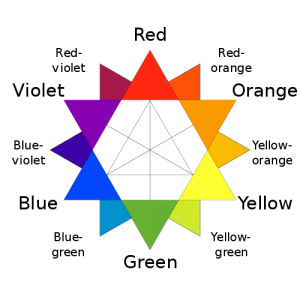

What about “sky” for blue? It may symbolize the heavens, other-worldliness, a greater/higher purpose. The same might be said for “ocean” (though there is water on the list). Both the sky and the ocean have the commonality of being a big expanse of the unknown…to be explored, feared, or wondered about (at least as it comes up in art therapy)
Very nice introduction. It reflects so much work in a concise manner. Thank you.
Excelent post. I wish more people could have access to it. Would you grant me permission to translate it into Portuguese and post to my blog? All credits will be given, of course. Thank you!
I would love to post this information on my website and give credit to the author. Angeles Arrien, a wonderful teacher of creativity and consciousness also gives indigenous meanings of colors which I have used for 20 years with my clients.
Hello, and thank you, for reflecting color messages!
Are the colors symbols of a longing for, or a feeling of?
How do we make sense of girls so, drawn to pink. And boys not, but blue?
Thanks,
Tamara
Well originally they would place babies of both sexes in white dresses. Soon pastel baby clothes were beginning to be produced and they made boys wear pink cause it was a ‘stronger’ color and girls wear blue because it was considered ‘delicate’. Soon manufacturers just started producing blue for boys and pink for girls in the 1940s. Then when tests concerning babies gender came around in the 80’s manufacturers realized that parents liked to buy gender-specific items for their baby. They started pushing out the whole boy blue, girl pink thing. Because of these customs each specific gender has been surrounded by that specific color for most of their lives from the clothes they wear to their toys. We’re drawn to these specific colors because they are familiar.
so thankful for this. painted a piece in sept/oct? completely different from anything I’ve done. Don’t remember anything about it, except that I knew that it was finished. It was to the ultimate extreme minimalist for me, with colors I rarely use. I have no name for it, don’t know its meaning, and don’t understand it. All I know is it evokes a strong emotional response from me that I am unable to even identify. I will use the color meaning/symbolism chart to see if it helps. (I have not posted this picture on my website.) I don’t even have it hanging anywhere.
Marisa
Outsider Artist
@Angelica and @Yvonne,
Thank you for the kind comments and feel free to use whatever you like!
hello! my name is wendy brightbill and i am a mixed media artist and i was in a car accident six years ago. i have witnessed firsthand the healing properties of art. i would love to share my story with you. i have searched your entire blog for a contact email and i couldn’t find one. just wondering if i could email you with a guest post proposal? let me know. thanks! you can visit my blog and website to find out more about me. thanks!
wendy
Its really easy to understand the meaning of colors your paiting the way you explained here is good worthful to spend some time to here.
Thanks
Gurudevaswami Hiremath
what are the other names for blue in indian language sanskrit
frequently
Ver interesting article! Thanks for sharing!
I am an artist, I like to know more about the meaning of the colors.
Thanks a million
This is indeed the beauty of whole damn thing. There is so much wisdom and expression in colors; they are just abundant with feelings. Go for the purity of white or passion of red, choose what reflects your taste better. Thanks for sharing such detailed information on colors. This will be a great help 🙂
I finally. Had closure from 17 years of child hood abuse after 37 years trying to heal!. I want to make some for this time in my life. What would be the color for closure? Hope you can help.
I am looking at how to use color for my website and blog. Thank you for this information. Right now I have both blue and blue green used. Interesting because those colors evoke trust, truth, transparency. I know a good color with blue is yellow from a visual standpoint of contrast. Yellow brings the idea of warmth, confidence and joy. I’d love your thoughts
I also see how color is related to the Houses in the Horoscope, Astrologically speaking… As Astrology is really but a language of energy…very interesting
This is really interesting, I have noticed how colours affect me and my family always remark when I am wearing black because i mostly wear bright colours. In my home I love the peacefulness of cream, I see it as a blank canvass upon which I can add splashes of colour – my favourite of which is turquoise. I agree with the extravert – I identify with that trait.
My client used a black marker for some of her markings. Any research on neutral colors?
this is really interesting and helpful! thanks!
Thank you so much for making this! I have to look into art therapy for a big project at my high school and this is exactly the information I was looking for. Very useful site and very helpful for what I was trying to achieve, so thanks!!
What about help what does help symbolise?
This is very informative article. Never thought that colors has so many meanings.